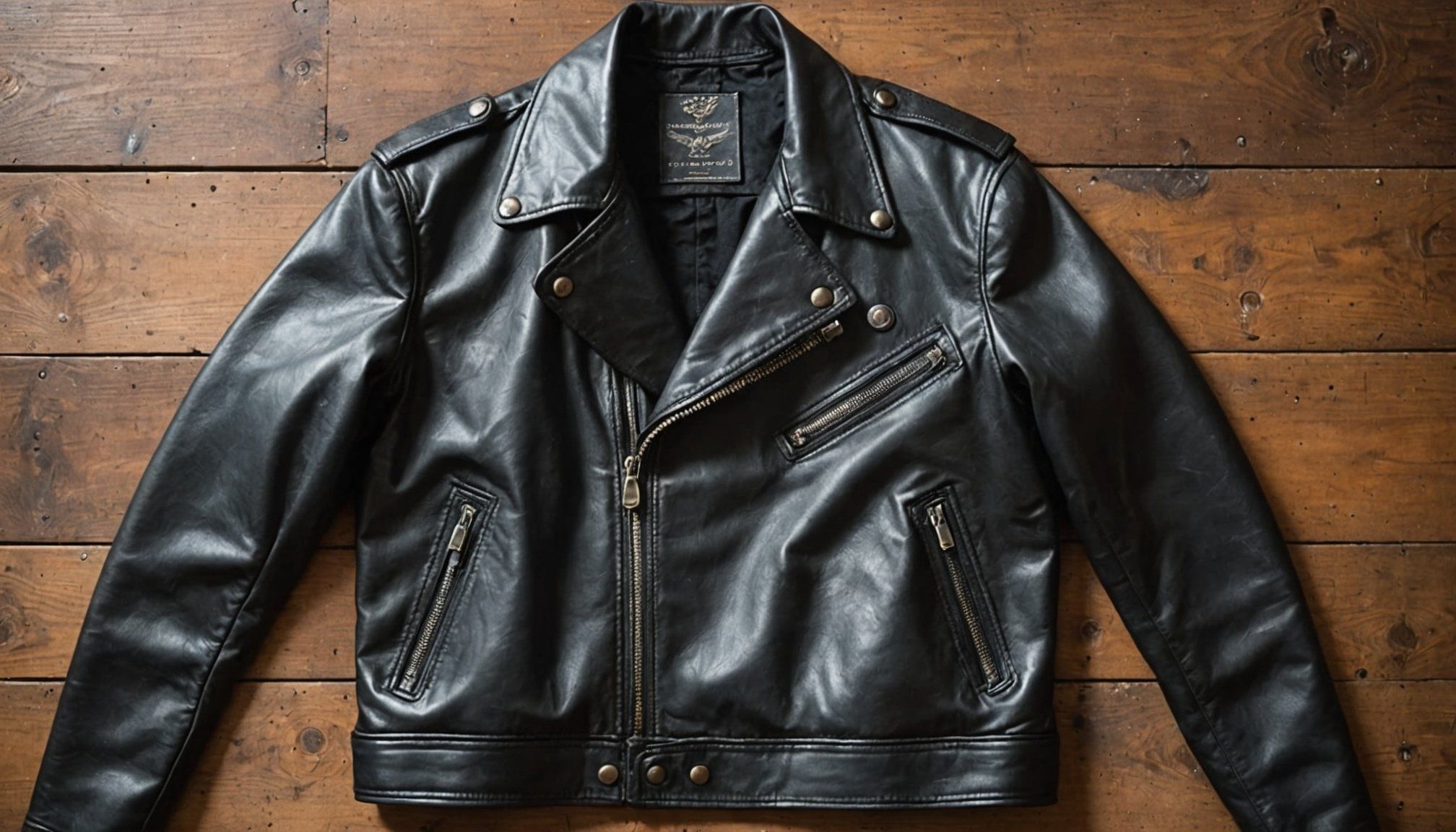Understanding Leather Jacket Materials
When it comes to leather jackets, understanding the materials is crucial. Whether you’re searching for vintage leather pieces or selecting new ones, knowledge of leather types plays a key role. Jackets are crafted using a variety of leather types, most commonly full-grain, top-grain, and corrected-grain leather. Full-grain leather is the most durable, retaining the natural grain, making it ideal for a jacket that ages beautifully. Top-grain leather is more refined, being slightly sanded and polished for a smooth appearance, offering flexibility without the natural imperfections.
Corrected-grain leather, on the other hand, is sanded and embossed to hide flaws, leading to less durability and breathability. For restoration enthusiasts, identifying these differences is important, especially when reviving vintage leather items. Each material’s characteristics affect how it can be restored and cared for. Full-grain needs specific conditioners to maintain its quality, while corrected-grain may need extra protection against environmental factors.
This might interest you : Discover the pioneering uk brands revolutionizing eco-conscious activewear with recycled polyester
Understanding these nuances ensures you select the right jacket for your needs and approach restoration with the confidence needed to preserve the piece’s integrity.
Assessing the Condition of Your Jacket
Conducting a thorough jacket assessment is pivotal before proceeding with any restoration work. Start by creating a clear checklist focusing on key aspects such as the overall appearance and structural integrity. Attention should be paid to common types of damage like scratches, stains, and tears, as these can significantly impact the jacket’s longevity and aesthetic value.
Also to discover : Ultimate guide to non-slip shoes perfect for navigating the uk”s rainy weather
When identifying damage, carefully inspect seams, zippers, and linings for issues like fraying or malfunction. Additionally, note any discoloration or patchy spots that may indicate compromised leather surfaces. It’s important to investigate the level of wear, particularly on the elbows and cuffs, as these areas are prone to more frequent use and, consequently, greater wear.
A thorough assessment provides valuable insights into the restoration evaluation process by highlighting areas that require immediate attention. Recognising the type and extent of damage will guide you in choosing appropriate repair methods and products suited to the jacket’s condition. Understanding the full scope of the issues ensures effective restoration, preserving the value and appearance of your leather jacket. This careful evaluation underscores the necessity of accurate damage identification, setting the foundation for a successful restoration.
Step-by-Step Restoration Techniques
Restoring a leather jacket requires meticulous restoration methods. Begin by cleaning the jacket thoroughly to eliminate dirt and oils. Use a gentle leather cleaner paired with a soft cloth or sponge for optimal results. Test a small area first to ensure the cleaner is suitable for your leather type.
When addressing scratches and scuffs, conditioning and polishing are effective techniques. Opt for leather conditioners to moisturise the leather, helping to diminish the visibility of minor scratches. For deeper scuffs, a coloured leather polish can be employed to even out discolouration.
For more extensive damages like seam splits and tears, patching and stitching techniques are necessary. Use leather-compatible adhesives or needle and thread to secure patches firmly onto the leather. Ensure stitches are tight and even to maintain the jacket’s structural integrity.
These DIY leather care steps are essential in reviving the jacket’s original allure. Each technique, from cleaning to repair, contributes to extending the jacket’s life while maintaining its charm. Always consider the specific leather type to tailor the restoration process effectively, ensuring success with your restoration efforts.
Recommended Products and Tools for Restoration
Restoring leather jackets demands specific leather restoration products and tools to ensure proper care and longevity. Essential products include leather conditioners, cleaners, and coloured polishes tailored for various leather types. Conditioners are crucial for preserving moisture, preventing cracking, and maintaining suppleness. Cleaners remove dirt and oils effectively, while coloured polishes help restore colours marred by scratches.
For DIY enthusiasts, having the right tools is equally important. Soft brushes are excellent for evenly applying conditioning creams, and specialised adhesives are indispensable for repairing tears and splits. A penetrating dye applicator can be used for more extensive colour restoration efforts, allowing smooth application without streaking.
When it comes to recommended brands, several names stand out in the UK market for their quality products. Brands like “Renapur,” known for versatile leather balsams, and “Leather Honey,” recognised for its long-lasting conditioners, remain popular. “Fiebing’s” offers exquisite dyes and finishes to cater to a range of restoration needs.
Using these recommended products and tools can streamline the restoration process. They provide access to quality treatments essential for safeguarding and refurbishing leather jackets, preserving their elegance and durability.
Caring for Restored Leather Jackets
Once your jacket has undergone successful restoration, maintaining it becomes essential to prolong its life. Regular leather care ensures the jacket retains its quality and appearance. Leather care tips include gently wiping down the jacket with a damp cloth to remove surface dust and grime. Use dedicated leather creams periodically to keep it soft and hydrated.
Incorporating seasonal cleaning and conditioning routines is also beneficial. During colder months, protect your jacket from moisture by applying a water-repellent spray. In warmer seasons, avoid direct sunlight to prevent discolouration and drying. Conditioning every few months will ensure the leather remains supple and resistant to cracking.
Proper storage plays a vital role in maintaining a jacket’s shape and quality. Store your leather jacket on a padded hanger to preserve its shape, and cover it with a breathable fabric bag to protect against dust whilst allowing air circulation. Avoid storing it in plastic or non-breathable materials to prevent mildew and musty odours.
By following these strategies, you contribute positively to your leather jacket’s longevity and appearance, ensuring it remains a classic piece in your wardrobe.
Sourcing Classic Leather Jackets in UK Marketplaces
Finding exquisite vintage jackets can be both thrilling and daunting. The UK offers a splendid array of marketplaces where these timeless treasures can be sourced. Look to renowned marketplaces like eBay or Depop for vast selections and hidden gems. Brick-and-mortar stores, such as Rokit and Beyond Retro, allow tangible inspection to verify authenticity directly.
Spotting quality jackets requires a keen eye. First, inspect the leather—full-grain leather indicates quality. Evaluate the stitching for evenness and strength. Check zips and buttons for functionality, as damaged hardware is common in older jackets. Be wary of counterfeit goods by purchasing from reputable sellers and scrutinising details like branding and interior tags.
Understanding price points is key to value assessment. Prices can wildly fluctuate based on the leather’s type, condition, brand, and rarity. Research typical market rates for desired brands or styles to ensure a fair deal.
Ultimately, mastering the vintage leather jacket market is about vigilance and informed decision-making, ensuring that each acquired piece is an authentic slice of fashion history.
Case Studies: Before-and-After Restoration Examples
Exploring real-life restoration examples offers invaluable insights into the transformative power of effective techniques. Here, we present captivating transformation stories that highlight how restoration methods breathe new life into old leather jackets, turning worn pieces into coveted treasures.
One notable case involved a beloved vintage jacket showing significant wear and deep scuffs, severely affecting its appearance. By employing a combination of leather cleaning techniques and targeted repairs, such as using leather-compatible adhesives for seam splits, the jacket achieved a remarkable transformation. Before-and-after visual comparisons revealed a stunning improvement, showcasing the jacket’s restored vibrancy and architecture.
Another success story demonstrated the impact of addressing minor scratches with precise DIY leather care. Through careful conditioning and polishing, a jacket marred with surface imperfections regained its smooth finish and rich colour, proving that even the smallest efforts make a substantial difference.
These examples serve as inspiration and guidance for those embarking on their leather restoration journey. They underscore the profound satisfaction gained from witnessing the dramatic renewal of cherished items and highlight the importance of tailored restoration approaches. Each project not only rejuvenates the jacket but reinforces the timeless allure of leather craftsmanship.
Additional Resources for Leather Restoration
Venturing into leather restoration can be greatly enhanced by tapping into various restoration guides and community resources. Numerous books and online resources provide in-depth knowledge and practical tips for DIY enthusiasts. Engaging with these materials can assist you in mastering techniques, ensuring your leather jackets maintain their allure.
Exploring community resource platforms like online forums is invaluable for sharing experiences and gaining insights into real-world challenges. These forums offer a space to exchange advice, learn from seasoned restorers, and gain confidence in executing your restoration projects. They bridge the gap between theoretical knowledge and hands-on application.
Connecting with experts and accessing professional expertise is crucial, especially for complex repairs. Whether it’s via online consultations or local professionals, these connections provide tailored advice, allowing you to address unique challenges specific to your jackets. They can recommend specialist products and techniques that elevate the restoration quality.
Lastly, many leather enthusiasts share tutorials and guides in restoration-focused communities, providing step-by-step breakdowns and troubleshooting advice. By diving into these additional resources, restorers can expand their knowledge base, enhance their techniques, and bring out the best in their cherished leather pieces.








